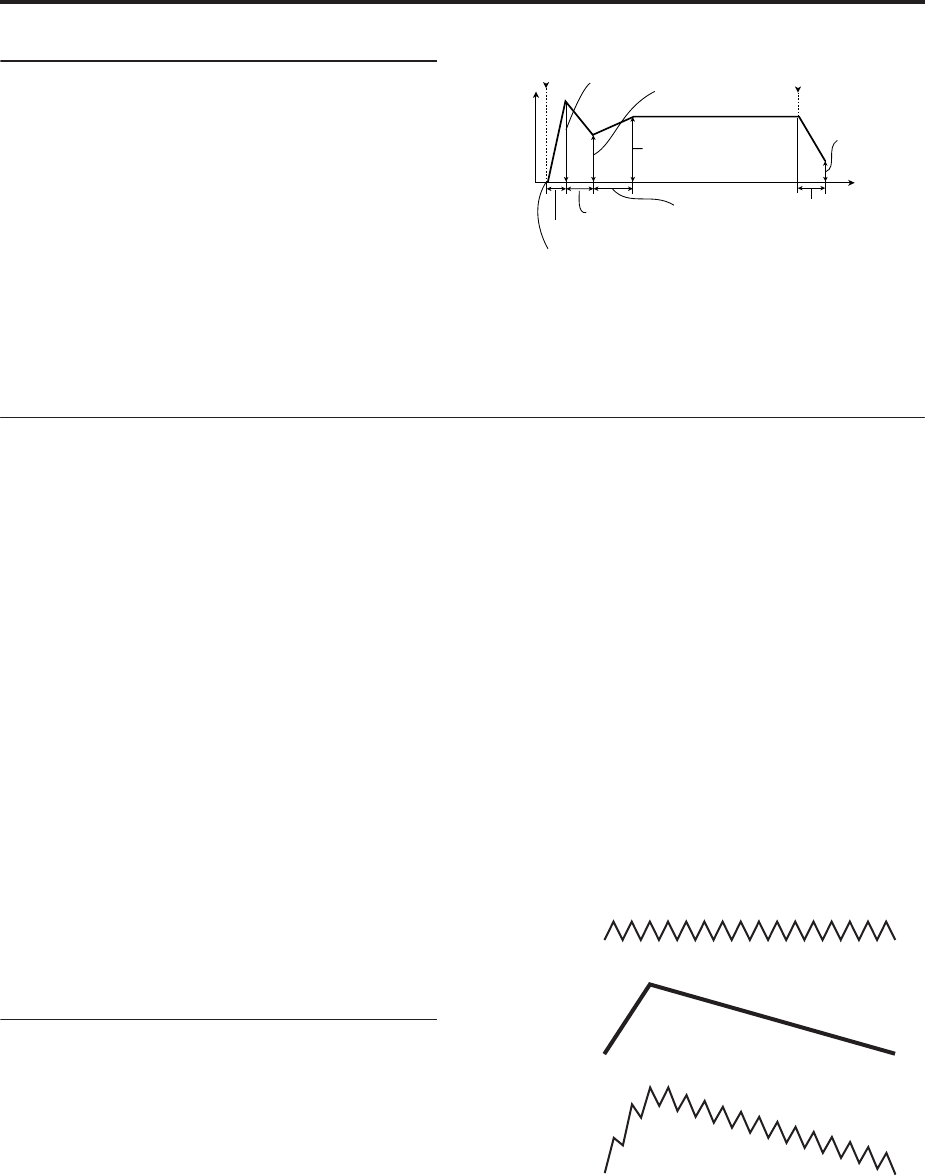
Playing and editing Programs
58
EGs (Envelope Generators)
An envelope creates a modulation signal by moving
from one level to another over a specified time, and
then moving to another level over another period of
time, and so on.
The HD-1 includes three EGs, for Pitch, Filter, and
Amp. These produce time-varying changes in pitch,
tone, and volume respectively. They can also be used
to modulate a number of other Program parameters
via AMS.
Using Alternate Modulation (AMS) and the AMS Mixers
AMS (Alternate Modulation Source) refers to any of
the assignable modulation sources in OASYS,
including:
• Built-in physical controllers, such as the Joystick,
Ribbon, and Real-Time Knobs
• Incoming MIDI controllers, or MIDI controllers
generated by KARMA or the Vector EG
• Modulators such as the Filter, Pitch, and Amp EGs,
the LFOs, or the AMS Mixers
Intensity is a parameter that sets the degree (speed,
depth, amount etc.) to which AMS will control the
modulation.
A number of frequently-used modulation routings,
such as using the joystick to vary the pitch, are
provided as additional, dedicated routings, separate
from AMS.
Note that not all AMS sources may be available for
some modulation destinations.
For details on alternate modulation and AMS, see
“Alternate Modulation Sources (AMS),” on page 965 of
the Parameter Guide.
Using the AMS Mixers
The AMS Mixers combine two AMS sources into one,
or process an AMS source to make it into something
new.
For instance, they can add two AMS sources together,
or use one AMS source to scale the amount of another.
You can also use them to change the shapes of LFOs
and EGs in various ways, modify the response of
realtime controllers, and more.
The AMS Mixer outputs appear in the list of AMS
sources, just like the LFOs and EGs.
This also means that the original, unmodified inputs to
the AMS Mixers are still available as well. For instance,
if you use LFO 1 as an input to a AMS Mixer, you can
use the processed version of the LFO to control one
AMS destination, and the original version to control
another.
Finally, you can cascade the two AMS Mixers together,
by using AMS Mixer 1 as an input to AMS Mixer 2.
Adding two AMS sources together
AMS mixers will do different things depending on
their Type setting. The A+B setting merges two AMS
sources into one. This can be handy when you need to
add one more modulation source to a parameter, but
you’ve already used up all of the available AMS slots.
For instance, let’s say that you’re using an LFO to
modulate Filter Resonance, and then you decide that it
would be interesting to scale that parameter with an
EG as well. Resonance has only a single AMS input,
but you can easily merge the LFO and the EG together
using the A+B AMS Mixer:
1. Assign the LFO to AMS A.
2. Assign the EG to AMS B.
3. Assign the AMS Mixer as the Filter Resonance
AMS source.
AMS Mixer A+B example
Scaling one AMS source with another
When the Type is set to Amt A x B, the mixer uses the
AMS B input to scale the amount of AMS A. For
instance, you can control the amount LFO1 with the
Filter EG, or control the amount of the Pitch EG with
the ribbon.
Level
Time
Attack Time
Decay Time
Slope Time
Release Time
Attack Level
Start Level
Sustain Level
Break Level
note-on note-off
Release Level
AMS A: LFO
AMS B: EG
A+B Output


















